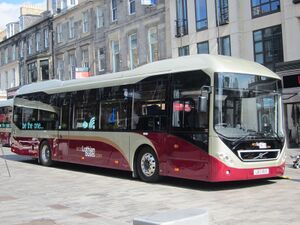Volvo Buses 7900

| |
| Years of manufacture | 2011 to present |
| Length | 10.6 to 18 metres |
| Width | 2550 millimetres |
| Power/Fuel | Diesel, CNG, Hybrid, Electric |
The Volvo Buses 7900 is a line of low floor transit buses available as a 10.6- or 12-metre rigid or 18-metre articulated model. It was launched in October 2011, and began selling as of 2012. The lighter 7900 range replaced Volvo's 7700 range and has a 70 per cent parts commonality with the 8900 range introduced prior.
Like the 8900, the 7900 uses a bolted aluminium structure and roof along with steel front and rear structures. The side panels, adhered to the frame with high strength adhesive, are of fibreglass and various composite materials. The weight of the 7900 is 550 kilograms less than the 7700.[1]
The 7900 may use a diesel, CNG, parallel hybrid, or battery-electric drivetrain. The hybrid option was initially only available on the 12-metre model, however coincident with Euro 6 legislation, a hybrid articulated model was introduced. Furthermore, as of 2014 Volvo only offers the 7900 as a hybrid for the European market. This is part of their move to producing fully electric powered vehicles.[2]
With the 7900 Electric Hybrid buses are capable of operating in full-electric mode for approximately seven kilometres. External electric charging is offered to extend the range of full-electric operation of the bus. Buses are charged in about six minutes with an overhead pantograph. Such buses have been deployed in Göteborg, Sweden as of 2013 as part of the ElectriCity initiative.[3] Beginning in June 2015, another trial introduced three fully-electric buses on a new route in the city. These specially designed buses are 10.7-metres long and feature a different look with more striking headlights and orthogonal window lines. The buses have two extra-large doors at the middle and a centralized driver's position. Volvo unveiled their production 12 metre 7900 Electric at the 2016 Busworld trade show in Kortrijk, Belgium. With 600 volt, 76 kilowatt-hour batteries, the electric 7900 has a range of 10 kilometres after recharging for three to six minutes. In the summer of 2017, Sales-Lentz, a bus operator in the Luxembourg city of Differdange, became the first to place the fully-electric 7900 in service.[4]
In mid-October 2017, Volvo announced enhancements to their 7900 Electric. Battery capacity was increased and is available in 150, 200 and 250 kWh capacities offering a range of up to 200 kilometres. In addition to the ABB OppCharge open-interface patograph fast-charge system, a plug-in Combined Charging System is now available. The updated 7900 Electric was launched at the 2017 Busworld trade show in Kortrijk, Belgium.[5] In 2019, Volvo introduced increased battery capacities of 198, 264 and 330 kWh.
Volvo introduced an articulated version of the 7900 Electric at the 2019 UITP Global Transport Summit in Stockholm. Prototypes had been in service in Gothenburg since June 2018, logging 4,500 hours and 62,000 kilometres of operation. A wider launch took place in October 2019 at Busworld in Belgium. The 7900 Electric Articulated is available in lengths of 18 and 18.7-metres.[6] It has a battery capacity of up to 396 kWh.
Volvo introduced the 7900 S-Charge in 2020. A self-charging hybrid bus, it does not need an external charger to operate in extended all-electric mode. It can run at a speed of up to 50 kilometres per hour for 1 kilometre in all-electric mode instead of the previous 20 kilometres per hour.
Specifications
| Dimensions | ||
|---|---|---|
| Length: 10.639m, 12.084m, 18.084m, 18.557m | ||
| Width: 2550mm | ||
| Height: 3224mm (hybrid, 2011 to 2014), 3280mm (hybrid, 2014 to present; battery electric), 3230mm (diesel) or 3356mm (CNG) | ||
| Wheelbase: | ||
| Engine | Emissions | Availability |
| Volvo D5F 4.76 litre, 215 hp | Euro 5/EEV | 2011 to 2014, 12m hybrid |
| Volvo D5K 5.1 litre, 240 hp | Euro 6/EEV | 2014 to present, 12m & 18m hybrid |
| Volvo D9B 9.36 litre, 260 or 310 or 360 hp | Euro 5/EEV | 2011 to 2014, diesel |
| Volvo D9G 9.36 litre, 300 hp | Euro 5/EEV | 2011 to 2014, CNG |
| Transmission | Availability | |
| Voith D864.5 | Diesel and CNG | |
| Volvo AT2412D | Hybrid | |
| ZF 6AP1400B | Diesel and CNG | |
| ZF 6AP1700B | Diesel and CNG | |
| Hybrid system | ||
| Volvo I-SAM electric motor/generator w/ Li ion batteries | ||
| Battery-electric system | Availability | |
| 160 kW, 400 Nm traction motor with 2-speed transmission | 10 to 12m buses | |
| 2 x 200 kW traction motor with 2-speed transmission | 18 & 18.7m buses | |
| Front axle | ||
| Volvo RFS-Low | ||
| Drive axle | ||
| ZF AV 132 | ||
| Suspension | ||
| Electronically controlled air suspension | ||
| Brakes | ||
| Disc brakes | ||
| Steering | ||
| Electrically powered hydraulic steering | ||
Operators
Singapore 
- Land Transportation Authority (LTA) (On order) [Most likely will go to SBS Transit]
Spain 
- Transports Metropolitans de Barcelona - Barcelona
Switzerland 
- Verkehrsbetriebe Luzern - Lucerne
United Kingdom 
- First Essex - Essex County
- Lothian Buses - Edinburgh
References
- ↑ Volvo 7900 - lighter and more fuel efficient (press release). Volvo Buses. 20 October 2011.
- ↑ Volvo goes all-out on hybrid buses (press release). Volvo Buses. 19 September 2012.
- ↑ [1]
- ↑ [2]
- ↑ New Volvo 7900 Electric offers greater range and flexibility. Press release. 16 October 2017.
- ↑ Volvo presents new electric articulated bus – higher capacity, less noise and better air quality. Press release. Volvo Buses. 10 June 2019.